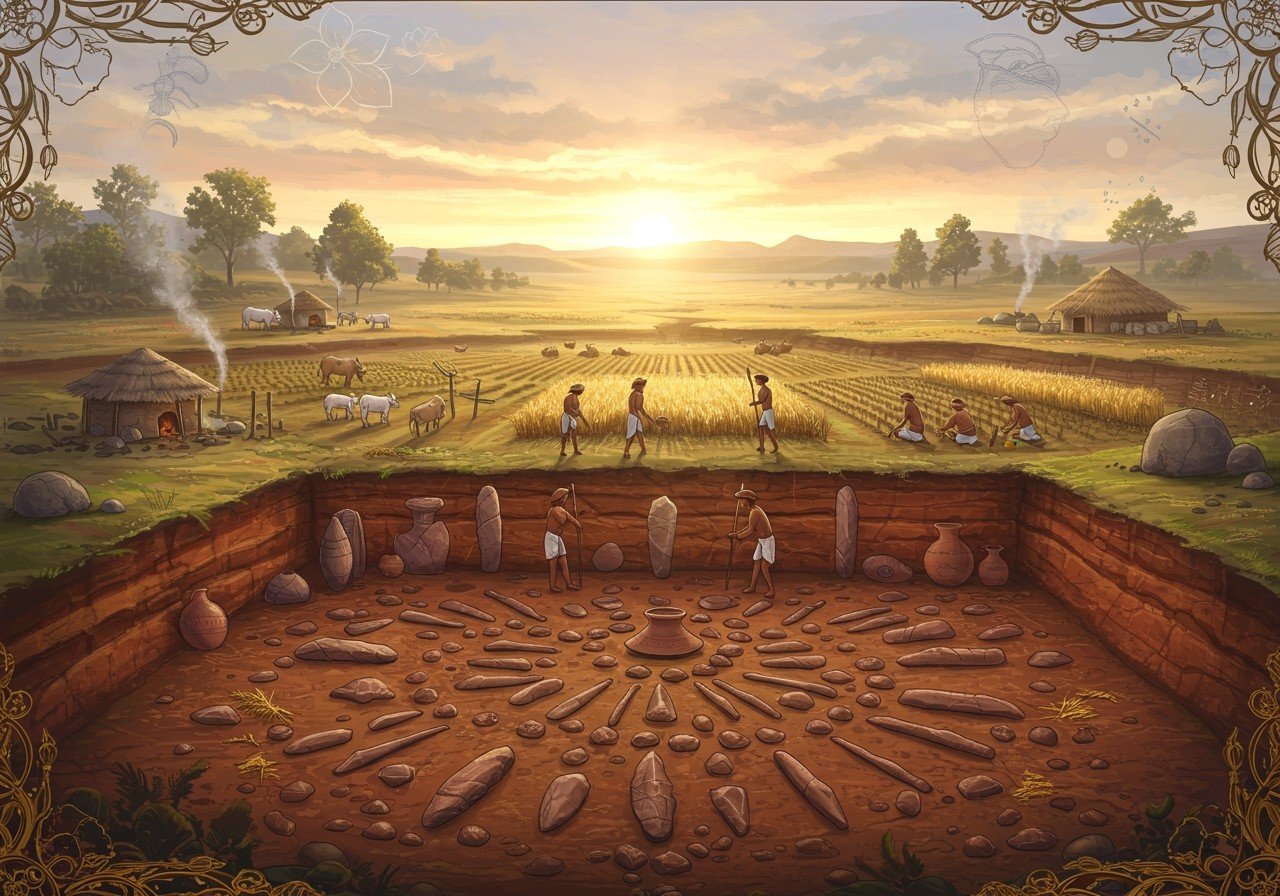
The Belan Valley, nestled in northern India, stands as a testament to a rich archaeological and cultural heritage. This fertile region, nourished by the Belan River, has cradled human civilization for millennia. The Neolithic site of Koldihwa, discovered within this valley, offers a captivating glimpse into the early agricultural practices, societal structures, and cultural evolution of ancient communities. This blog post delves into the profound history and cultural legacy of the Belan Valley, with a particular focus on the Neolithic period and the distinctive Koldihwa culture.
Geographical and Historical Context
Spanning parts of Uttar Pradesh and Madhya Pradesh, the Belan Valley is characterized by its fertile plains and abundant water resources. This richness has nurtured human life since the Paleolithic period. The Belan River, a tributary of the Ganges, has played a vital role in sustaining these communities. Its strategic location facilitated trade and cultural exchange, further enhancing its historical significance.
Koldihwa: A Neolithic Hub
Koldihwa stands as a prominent Neolithic site within the Belan Valley. Excavations have unearthed evidence of early agricultural practices, notably rice cultivation. The discovery of artifacts such as pottery, tools, and ornaments offers insights into the daily lives of these ancient inhabitants. Circular and rectangular dwellings suggest the presence of well-organized settlements. Radiocarbon dating indicates that Koldihwa was inhabited as early as 7000 BCE.
Agricultural Innovations
The inhabitants of Koldihwa were pioneers in agriculture, transitioning from nomadic lifestyles to settled farming communities. Rice cultivation played a crucial role in supporting larger populations. Evidence of irrigation channels and granaries points to sophisticated farming techniques. The surplus of food resulted in social stratification and the emergence of specialized crafts. This shift towards agriculture profoundly impacted the social, economic, and cultural fabric of Neolithic societies.
Material Culture and Artifacts
The artifacts unearthed at Koldihwa reveal remarkable technological and artistic achievements. Pottery, distinguished by its unique shapes and designs, stands out. Stone tools, including axes, blades, and grinding stones, demonstrate technological advancements. Ornaments crafted from shell, bone, and stone reflect personal adornment traditions. Beads and decorative items hint at the existence of trade networks. These artifacts offer a window into the daily lives, beliefs, and practices of the people of Koldihwa.
Social and Cultural Transformations
The Neolithic period in the Belan Valley witnessed significant social and cultural shifts. Sedentary agriculture fostered the growth of larger, more complex communities. A social hierarchy likely emerged with increasing populations. Permanent dwellings and storage facilities indicate changes in settlement patterns. Alongside Koldihwa, other notable sites such as Mahagara, excavated between 1975-1979, and Chopanimando, known for its pottery, contribute to our understanding of this era. The prehistoric cave paintings at Panchmukhi Hill in Sonbhadra further enrich the cultural tapestry of the Belan Valley.
Other Significant Sites
Beyond Koldihwa, the Belan Valley is home to other important Neolithic locations. Mahagara, excavated between 1975 and 1979, features the layout of a village and a cattle pen, providing valuable insights into early settlement planning. Chopanimando is recognized for its significant contributions to pottery making. These sites collectively paint a more complete picture of life in the Neolithic Belan Valley.
Conclusion
The archaeological treasures of the Belan Valley offer invaluable insights into the dawn of human civilization in India. From Koldihwa’s pioneering agricultural practices to the intricate artifacts and well-organized settlements, this region showcases the remarkable progress made during the Neolithic period. The transition from nomadic to settled life, the rise of agriculture, and the development of social structures are all beautifully preserved in this region’s rich heritage. Exploring the Belan Valley not only deepens our understanding of our ancestors but also highlights the enduring legacy of human innovation and resilience.
Connecting with the Spiritual Legacy of the Belan Valley
The Belan Valley’s Neolithic heritage speaks to our deep spiritual roots. Poojn.in, India’s largest cultural goods and services store, offers a wide selection of authentic items to support your spiritual journey. For those seeking to connect with the sacred significance of this region, we offer:
- Bel Mala (₹249.00): These sacred prayer beads, crafted from Bel wood, hold deep significance in Lord Shiva worship, resonating with the spiritual traditions of the region. Available in various sizes and styles.
- Shiva Lingam and Nandi Set: Honor Lord Shiva with this beautifully crafted set, perfect for creating a sacred space in your home. Available in various materials and sizes.
- Complete Pooja Samagri Kits: Ensure you have everything needed for traditional rituals with our comprehensive kits, containing all the essential items for a fulfilling spiritual practice.
- Holy Utensils: Enhance your ceremonies with our selection of traditional copper and brass items, crafted with care and reverence.
- Authentic Holy Idols: Invite divine presence into your home with our carefully crafted statues, representing various deities.
- Pure Holy Food Items: Offerings of pure and sanctified food items are an integral part of many rituals. Poojn.in provides a wide variety of options for prasad and other offerings.
Visit www.poojn.in to explore our complete collection of traditional ritual items and deepen your spiritual connection.
Related Articles
- Bhuteshwar Temples: A Journey Through India’s Sacred Sites
- Jyotirlingas of India: A Spiritual Journey Through Sacred Sites
- Varanasi: A Spiritual Journey Along the Ganges Ghats


